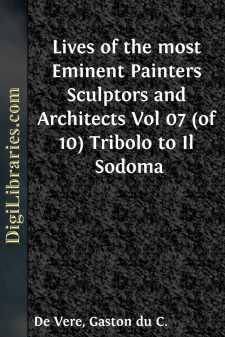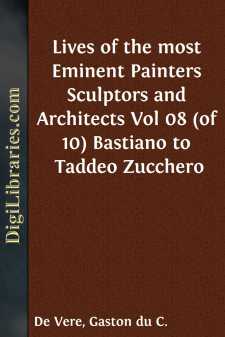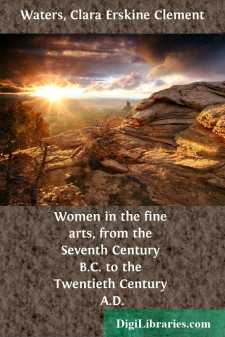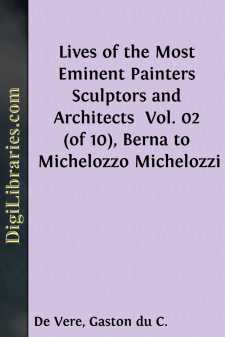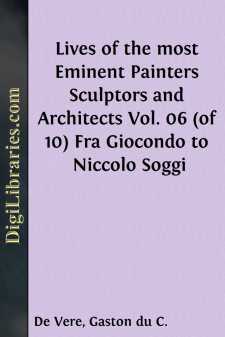Biography & Autobiography
- Adventurers & Explorers 15
- Artists, Architects, Photographers
- Business 2
- Composers & Musicians 14
- Criminals & Outlaws 5
- Editors, Journalists, Publishers 6
- Educators 1
- Entertainment & Performing Arts 3
- General 73
- Health, Exercise & Fitness 1
- Historians 3
- Historical 83
- Law Enforcement 1
- Lawyers & Judges 3
- Literary 147
- Medical 7
- Military 48
- Naturalists, Gardeners, Environmentalists 8
- Personal Memoirs & Diaries 226
- Philosophers 3
- Political 9
- Presidents & Heads of State 38
- Religious 38
- Rich & Famous 27
- Scientists 13
- Women 31
Artists, Architects, Photographers Books
Sort by:
LIFE OF NICCOLÒ, CALLED TRIBOLOSCULPTOR AND ARCHITECT Raffaello the carpenter, surnamed Il Riccio de' Pericoli, who lived near the Canto a Monteloro in Florence, had born to him in the year 1500, as he used to tell me himself, a male child, whom he was pleased to call at baptism, like his own father, Niccolò; and having perceived that the boy had a quick and ready intelligence and a lofty...
more...
I A BIOGRAPHICAL OUTLINE In July of 1904 the eighty-seven mortal years of George Frederick Watts came to an end. He had outlived all the contemporaries and acquaintances of his youth; few, even among the now living, knew him in his middle age; while to those of the present generation, who knew little of the man though much of his work, he appeared as members of the Ionides family, thus inaugurating the...
more...
When Pietro Perugino, by that time an old man, was painting the altar-piece of the high-altar of the Servites at Florence, a nephew of Giuliano and Antonio da San Gallo, called Bastiano, was placed with him to learn the art of painting. But the boy had not been long with Perugino, when he saw the manner of Michelagnolo in the cartoon for the Hall, of which we have already spoken so many times, in the...
more...
While the most noble and industrious spirits were striving, by the light of the famous Giotto and of his followers, to give to the world a proof of the ability that the benign influence of the stars and the proportionate admixture of humours had given to their intellects, and while, desirous to imitate with the excellence of their art the grandeur of Nature in order to approach as near as possible to...
more...
INTRODUCTION In studying the subject of this book I have found the names of more than a thousand women whose attainments in the Fine Arts—in various countries and at different periods of time before the middle of the nineteenth century—entitle them to honorable mention as artists, and I doubt not that an exhaustive search would largely increase this number. The stories of many of these women have...
more...
Accusations of ingratitude, and just accusations no doubt, are made against every inhabitant of this wicked world, and the fact is, that a man who is ceaselessly engaged in its trouble and turmoil, borne hither and thither upon the fierce waves of the crowd, bustling, shifting, struggling to keep himself somewhat above water—fighting for reputation, or more likely for bread, and ceaselessly occupied...
more...
PAINTER OF SIENA If those who labour to become excellent in some art did not very often have the thread of life cut by death in their best years, I have no doubt that many intellects would arrive at that rank which is most desired both by them and by the world. But the short life of men and the bitterness of various accidents, which threaten them from all sides, snatch them from us sometimes...
more...
W psychoanalytic investigation, which usually contents itself with frail human material, approaches the great personages of humanity, it is not impelled to it by motives which are often attributed to it by laymen. It does not strive "to blacken the radiant and to drag the sublime into the mire"; it finds no satisfaction in diminishing the distance between the perfection of the great and the...
more...
If writers of history were to live a few years longer than the number commonly granted as the span of human life, I, for my part, have no manner of doubt that they would have something to add to the accounts of the past previously written by them, for the reason that, even as it is not possible for a single man, be he ever so diligent, to learn the exact truth in a flash, or to discover all the details...
more...
DONATELLO The materials for a biography of Donatello are so scanty, that his life and personality can only be studied in his works. The Renaissance gave birth to few men of productive genius whose actual careers are so little known. Unlike many of his contemporaries, Donatello composed no treatise on his art; he wrote no memoir or commentary, no sonnets, and indeed scarcely a letter of his even on...
more...


